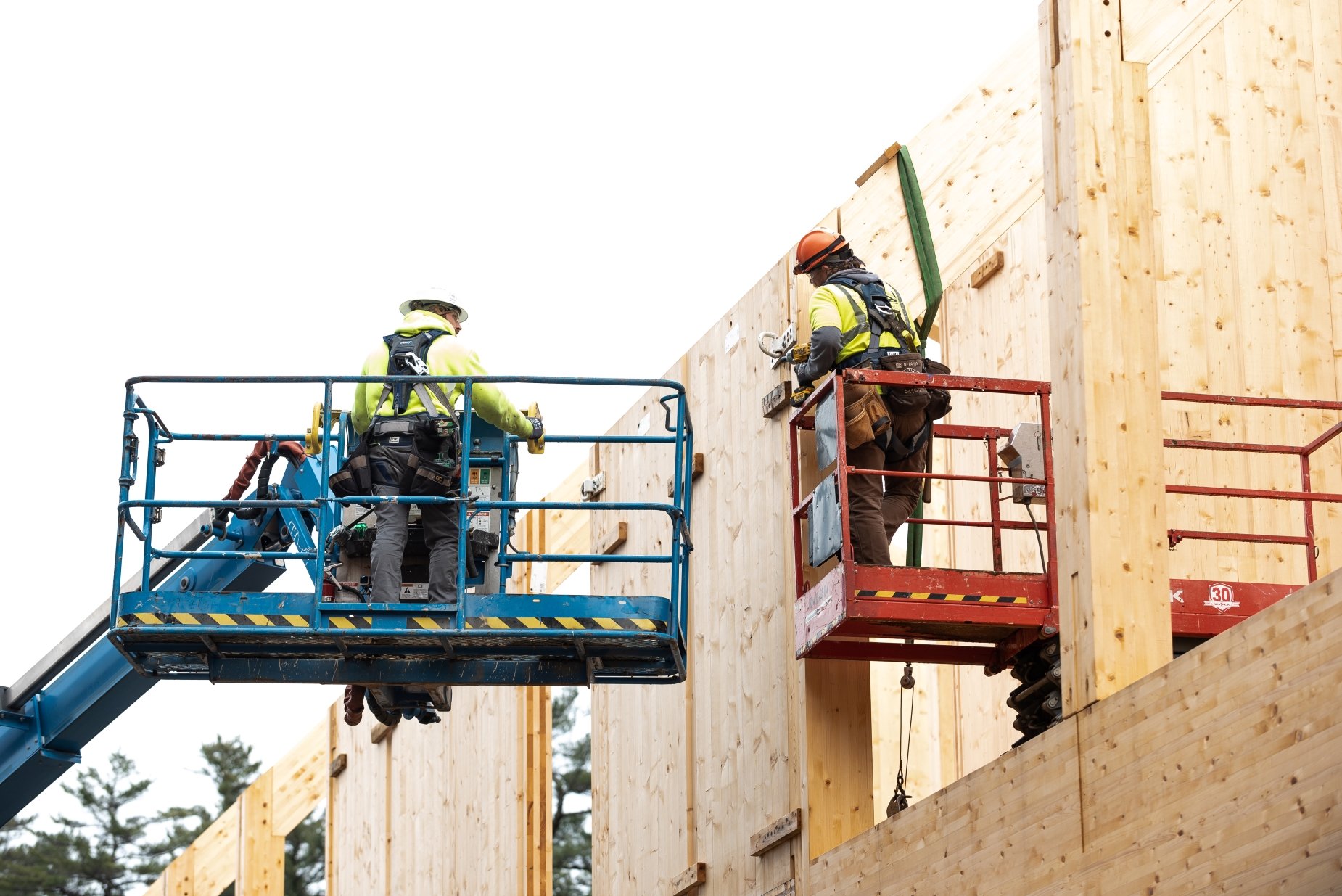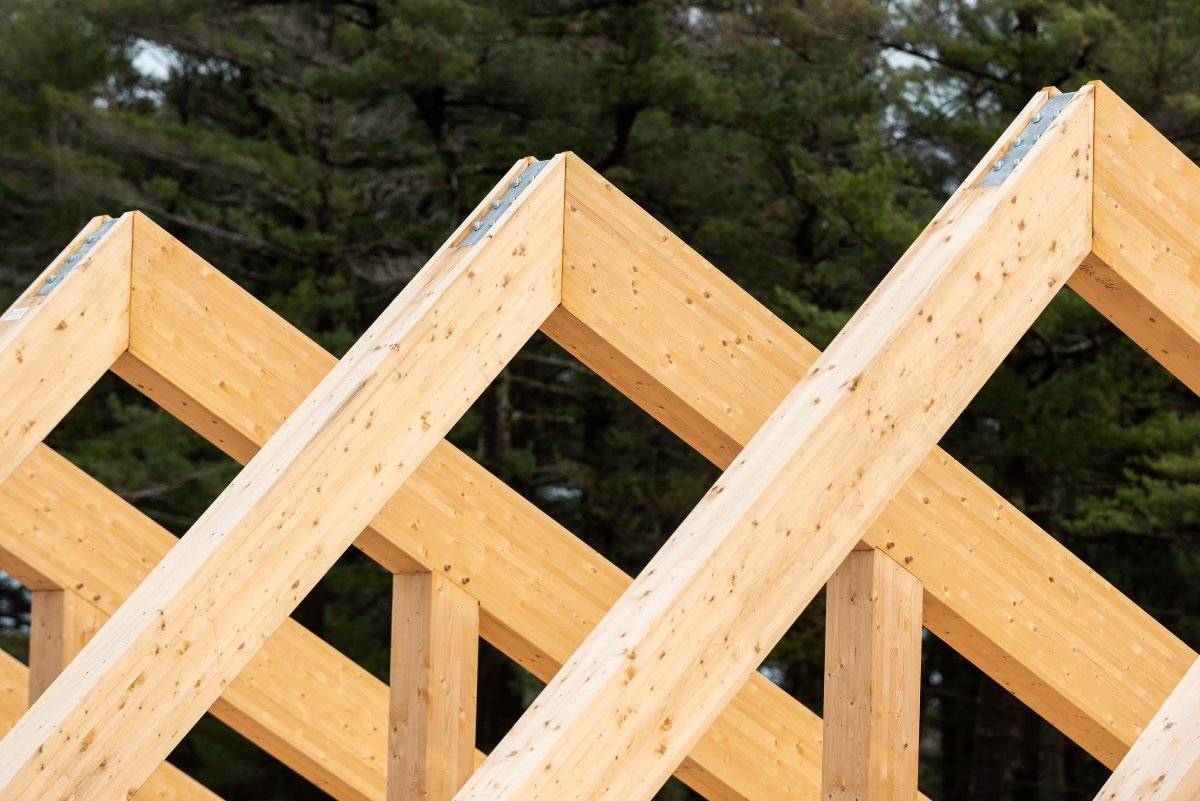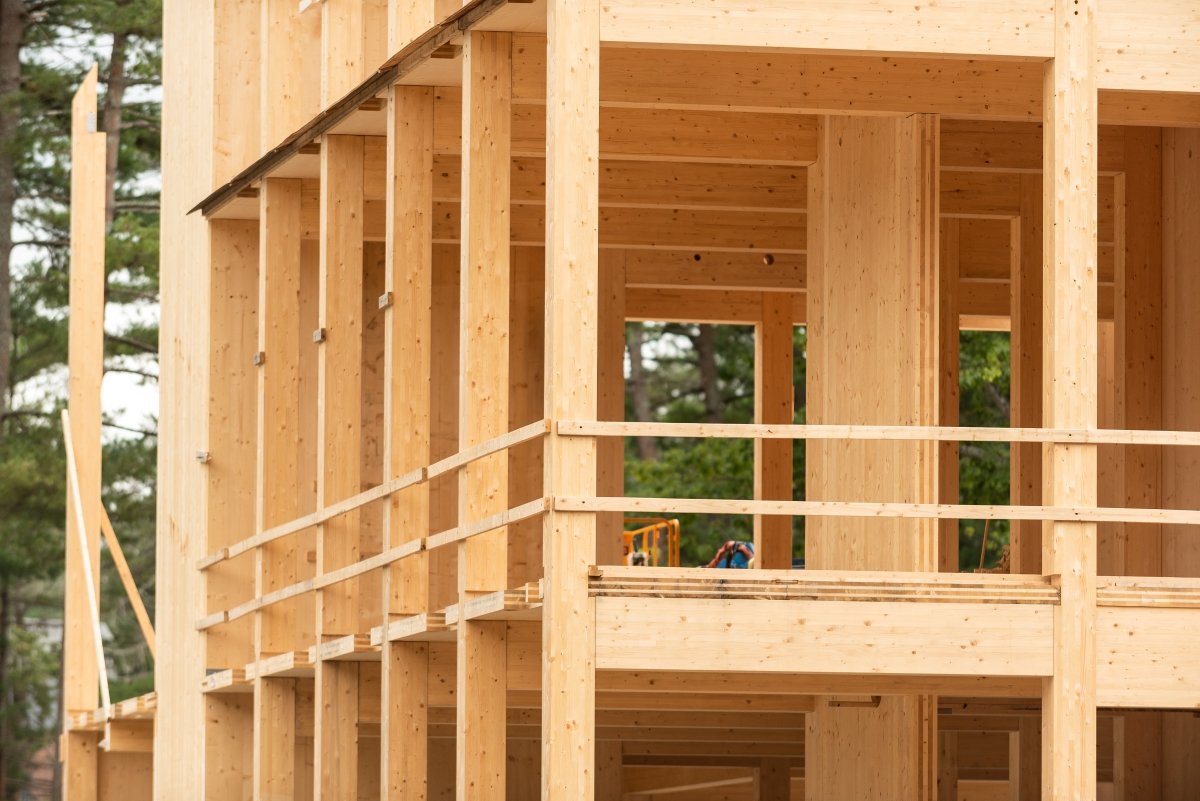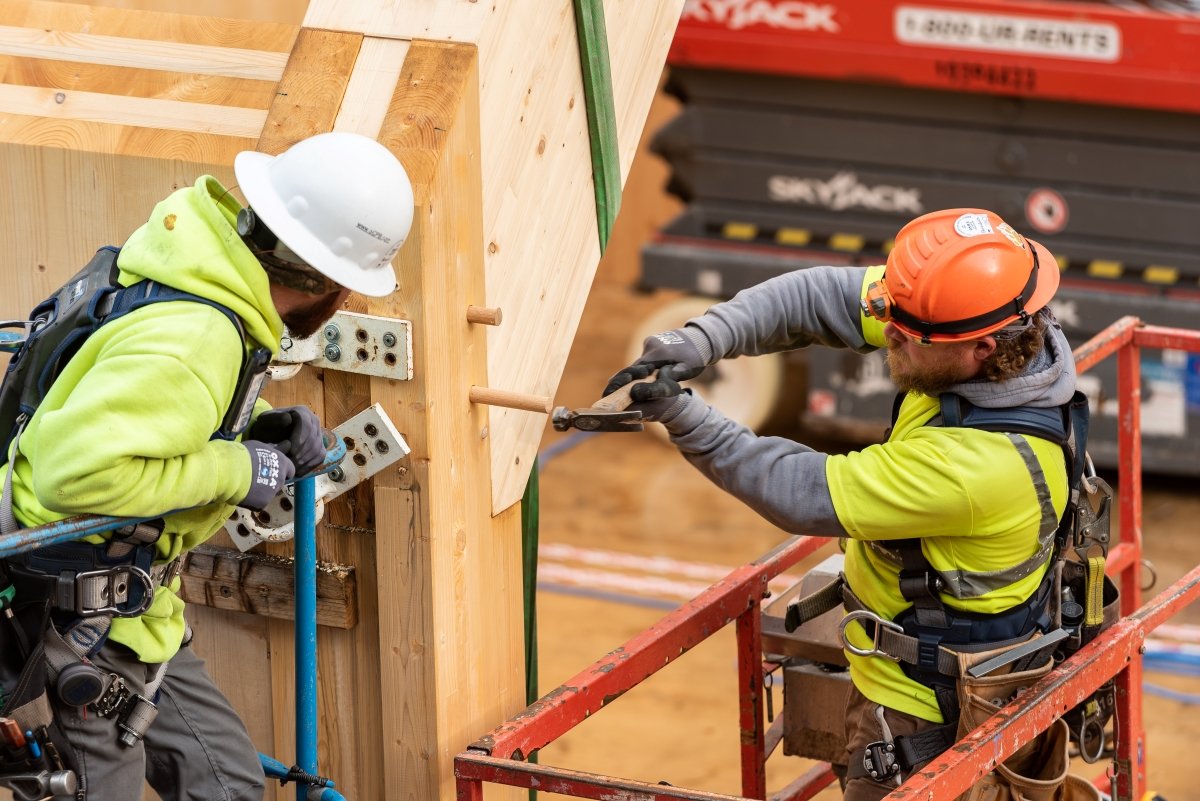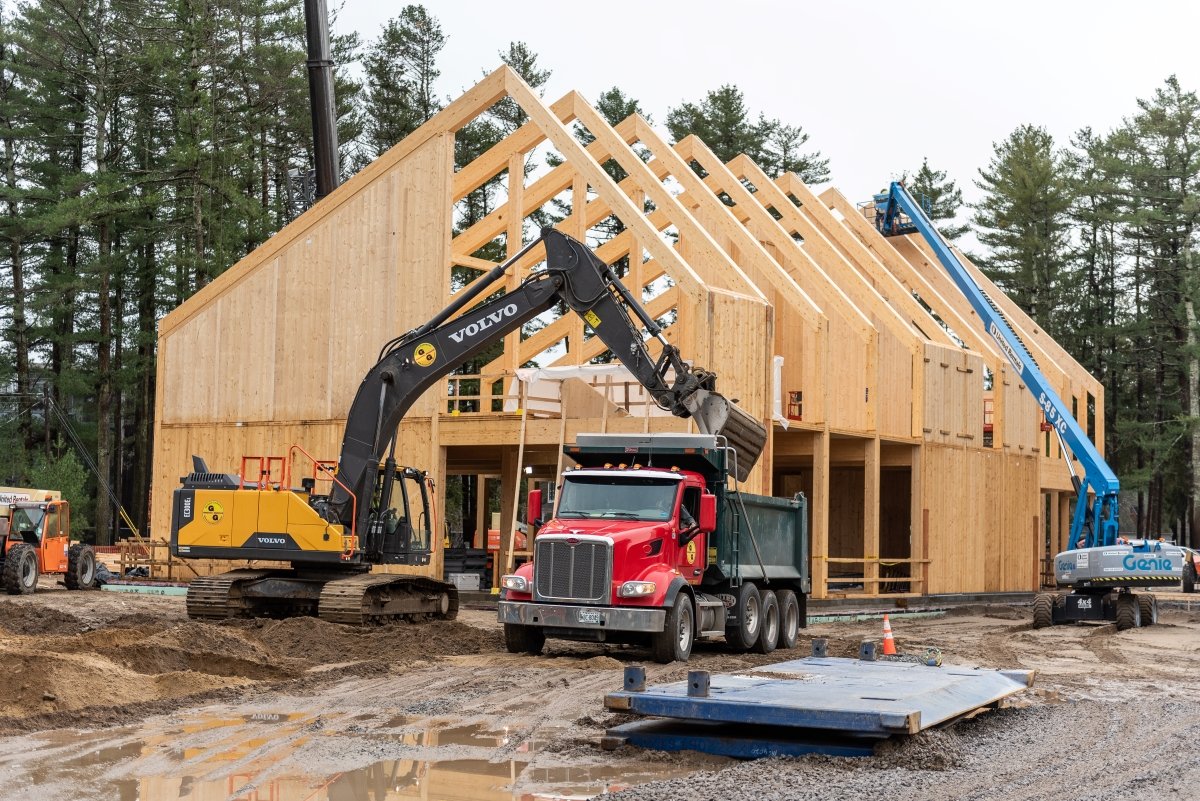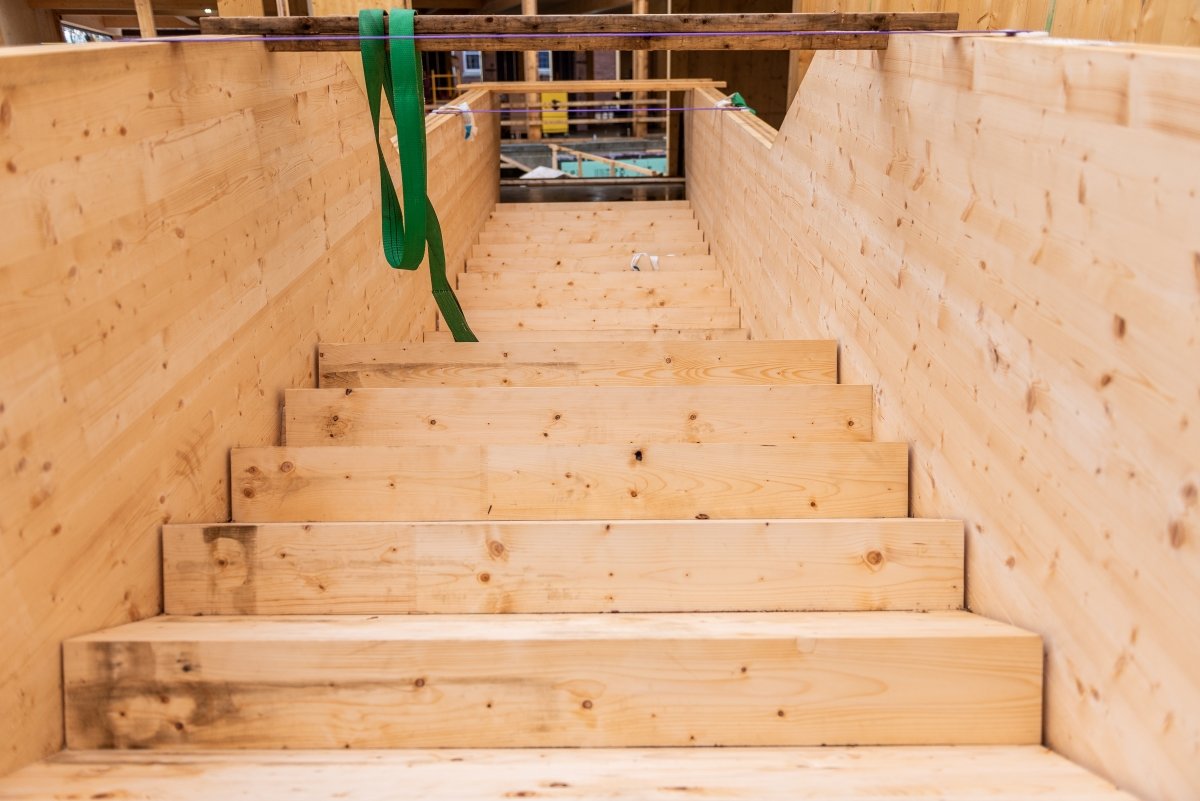CLT and glulam use expands in Maine
By Lee Burnett | Photos by Robert Umenhofer, courtesy of Consigli Construction, unless otherwise noted.
AN ASYMMETRICAL BARN ROSE amid the classic brick buildings at Bowdoin College during the fall of 2021. Massive timbers were swung into place by a crane and assembled like a piece of IKEA furniture. The architectural showpiece is the most prominent example in Maine of a new way of building with natural materials to combat climate change.
As the nation’s most forested state, Maine is looking to play a big role as a source of mass timber and other climate-friendly building materials. However, the start has been slower than expected. The timber used at Bowdoin, for example, comes from Austria.
Buildings account for 39% of carbon emissions. That includes the energy to operate a building over its lifetime, such as for heating, cooling and air conditioning. It also includes the energy embodied in the materials themselves: the emissions expended in manufacturing and transporting materials to the job site. Avoiding these early emissions, before the building is even occupied, is emerging as critically important in mitigating climate change before it is too late.
Wood: a low carbon building material
There are two ways that wood buildings can help. Wood contains carbon that has been cycled out of the atmosphere by trees during their lifetime. This cycling of carbon can be enhanced through better forestry. Sustainably harvested timber continues to store carbon while making room for new carbon-cycling forest growth. Secondly, if wood displaces large amounts of carbon-emitting material such as concrete and steel, this “substitution effect” can lighten the overall carbon footprint of the building.
Mass timber is the generic term for lumber that is engineered—by gluing or fastening it in various orientations—to carry heavier loads than standard lumber. Cross-laminated timber (CLT) refers to lumber glued in crisscross layers like plywood and used for entire floors and walls. Glulam (glued laminated) wood refers to lumber glued in parallel orientation and used for columns and beams. Nail-laminated timber and dowel-laminated timber are variations.
Both glulam beams and CLT panels were used in new buildings at Bowdoin College.
The new buildings at Bowdoin College—Mills Hall and the Center for Arctic Studies—contain as much wood as you’d find in a good-sized neighborhood. It adds up to 438,000 board feet of wood, which is roughly equivalent to 27 houses of 2,000 square feet each. But more relevant than the amount of wood used are the amounts of concrete and steel that were not. If Bowdoin had opted for conventional construction methods, they would have yielded 25.7 kilograms of CO2 equivalents per square foot, says Ethan Fogle, a structural engineer and expert in embodied carbon and life cycle analysis at the architecture and engineering firm HGA. Instead, according to Fogle, the new buildings yielded 5.06 kilograms of CO2 equivalents per square foot. “Five times less is pretty awesome,” Fogle says. The savings are roughly equivalent to taking 155 cars of the road for a year, he says. The savings would have been even greater had the mass timber been sourced from Maine, he notes. (Quantifying the full environmental impact of construction is an emerging field known as life cycle analysis. The initial calculations are approximations and will be updated with more precision once the buildings are complete.)
For Bowdoin College, choosing CLT as a building material is less about moving its own needle on carbon reductions and more about supporting broader climate-change mitigation strategies, such as environmentally benign construction materials and sourcing materials from local economies, says John Simoneau, Director of Capital Projects. To achieve more dramatic carbon emissions reductions, the college is investing in solar power, electrical efficiencies and transportation reform and ending its reliance on gas-powered heat, he says. These steps will enable Bowdoin to achieve carbon neutrality without relying on purchasing carbon offsets. “We absolutely want to be in a leadership role. We absolutely want to lead by example,” says Simoneau.
Mass timber is a booming industry nationwide and Maine is starting to get a taste of it
The number of mass timber buildings in the U.S. has more than tripled in the past three years, from 400 projects in 2018 to 1,303 at the end of 2021, according to WoodWorks, the educational clearinghouse for mass timber. Multiple factors are fueling the growth, says Ricky McClain, the mass timber expert at WoodWorks. He cites an increased focus on sustainability among the design and development community, aesthetics and market differentiation, speed of construction, potential for reduced on-site labor, advancements in the buildings code, education efforts in the build-design community and growth of the supply chain. The embodied carbon benefit of mass timber is driving a lot of demand, he says. “We are definitely going to see a continued focus on that.”
Maine has seen a handful of mass timber projects constructed or proposed. Besides the Bowdoin project, Avesta Housing has used CLT in place of concrete in the elevator shafts and stairwells in an apartment building in Portland and the elevator shafts of another apartment complex in South Portland. Mass timber is also being proposed for at least three large projects—at the University of Southern Maine, the University of New England and Rock Row in Westbrook—where it will replace steel beams and concrete, both of which have high embodied carbon.
Machine off site, CLT panels are quickly assembled with hardware.
While showcase projects drove the early stage of mass timber, the more common, utilitarian buildings are the ones that will give mass timber its staying power, according to experts. Examples can be found half an hour south of Bowdoin on the outskirts of the Maine Mall. Here, two five-story apartment buildings are under construction and will become affordable housing. It’s noteworthy that developer Avesta Housing found a place for mass timber in its tight budgets. It’s not a big place—just the elevator shafts. But CLT’s quick assembly time made it an easy decision, explains Todd Rothstein, Avesta’s director of construction services. “The builders erected the CLT shaft in two hours. And these are builders who had never done it before,” he says. Using CLT panels also avoided the $20,000 wintertime cost of building and heating temporary spaces to cure freshly laid concrete block walls, he reports. “CLT doesn’t require any of that,” says Rothstein. “The money savings are significant,” even though, he adds, CLT still doesn’t make financial sense for use elsewhere in an affordable housing project.
But in Maine, the measure of progress is not the number of new CLT buildings but the prospects for siting a manufacturing plant. Here, hope has turned to disappointment. Just a few years ago, two companies announced plans to build manufacturing plants. In 2018, Montana-based SmartLam announced plans to build a manufacturing plant in Millinocket and in 2019, North Carolina-based Ligna Terra announced plans to build one in Lincoln. Both projects were eventually shelved. In the meantime, at least two new CLT plants have been built elsewhere—in Ontario and British Columbia—bringing the total to 14 in North America.
WHy isn’t there a mass timber manufacturer in maine?
There’s been no lack of effort in the state. CLT was first ballyhooed in Maine in the fall of 2016 at both a Wood Innovators Conference in Hiram and the annual meeting of the Maine Forest Products Council. Maine developed a strategy to accelerate mass timber’s use as a replacement for steel and concrete in large construction projects and, with Maine Senator Angus King’s leadership, UMaine landed a $455 million federal grant to create the Maine Mass Timber Commercialization Center in 2017. A bullish report was issued three years later.
One person who has some insight is Charlie Levesque, president of Innovative Natural Resource Solutions in New Hampshire and a longtime leader in regional forest policy. Levesque recently visited a SmartLam CLT plant in Dothan, Alabama as part of a new regional CLT initiative and learned a few lessons about why SmartLam invested in a plant in the South rather than coming to Maine. Two big factors are significantly lower labor costs and lumber costs, he says. He also noticed the company has ample room to expand on-site, which probably means the company won’t be investing in Maine anytime soon. “For a few million dollars they can double capacity at that plant, versus spending $40 or $50 million to build here,” he says.
It’s fair to wonder if the financing climate in Maine is more risk-averse than elsewhere. It took GO Lab five years to secure $85 million in financing to develop a wood fiber insulation plant in Madison, and that’s based on a technology proven in Europe, an ample supply of wood chips, cheap hydropower at the nearby dam site, and favorable terms on equipment.
Robert Perschel, executive director of the New England Forestry Foundation (NEFF), has watched developments in Madison from afar and worries about its implications for a similar-size investment in a CLT manufacturing plant. “That’s a signal … something needs fixing,” he says.
Another big factor may be uncertain demand. While the number of new projects nationwide may be climbing rapidly, it’s unclear how much wood that represents. Russ Krauss, a business start-up consultant from Owls Head, spent considerable time exploring demand as part of a Maine Technology Institute study of the viability of using CLT in home construction. He interviewed key players and pored over reports, including a 2017 market report commissioned by NEFF from the Finnish consulting and engineering company Pöyry (now known as AFRY). “Demand is lumpy,” Krauss says. “If you’re building a plant, you want constant demand.”
Wood brings warmth and beauty to interior spaces.
Next steps for CLT in maine
The advocates pushing the CLT envelope today are working to lower manufacturing costs. One is a forester, and one is structural engineer. Both are passionate, impatient guys trying to make a difference outside their normal spheres. Although they are tackling different problems, their approaches are compatible.
Matt Tonello, head of Maine operations for Consigli Construction, is pushing to certify a different lamination process using pneumatic-driven wooden nails instead of glue. And Charlie Levesque is trying to get hemlock, an abundant, low-cost wood species, certified as a component of CLT.
Tonello says his passion is partly driven by anxiety over sourcing CLT from distant sources and managing complex supply chains. “It frustrates me I don’t have a consistent supply I can rely on. I have to manage the risk of transportation, cross-border shipping …,” his voice trails off. In addition to the nail lamination initiative, Tonello’s leadership has been instrumental in reforming Maine’s building codes to allow mass timber for larger buildings. “It has frustrated me for the last six years that we have not been able to attract a mass timber manufacturer to Maine, the most forested state in the nation. For me, it’s purely a personal passion.”
Tonello’s idea is to certify a lamination process that avoids—at least initially—the expensive automation in hydraulic presses and CNC (computer numerical control) machines. In its lowest-tech version, nail-laminated timber can be assembled by nail gunning standard dimensional lumber together in larger sizes. Tonello says a modest investment at an existing lumber mill might be the way to go. That would take advantage of an existing supply chain, kiln-drying capacity, trucking and human know-how.
“The capital cost to start or establish a CLT plant is huge,” Tonello says. “I think if there’s a way to lower the capital cost, it could entice someone to start.” A low-cost, labor-intensive process could eventually be replaced by a more automated process, he says.
In the meantime, Levesque is working with the University of Massachusetts to test the viability of hemlock, which would provide a cheaper alternative to already-certified species spruce and fir. Using hemlock would not only lower manufacturing costs, but would also create new demand for an abundant, under-utilized species, which would provide an economic boost to rural economies. Levesque is driven by a passion for all things forestry. Besides being a forester, he is a fine woodworker, maple syrup producer and all around “wood geek,” as he calls himself. He argues that creating new markets for wood products helps ensure forests are maintained as forests, rather than sold for development. “It sounds counterintuitive, but it’s true,” he says.
Certification of hemlock is likely, although it takes time, Levesque says. The pilot project is a multi-family building in Boston, which he says is a far more “replicable” project than the more glamorous ones.
The next big CLT step forward could come later this year. A coalition of forest-based organizations led by the University of Maine has been awarded $500,000 and chosen as a finalist to compete for up to $100 million to accelerate the transition of Maine’s forest economy to the production of new products. If successful, significant funding would be available for CLT market development, supply chain stimulation and construction of a $30+ million Green Engineering & Materials Laboratory at the UMaine campus at Orono. The coalition includes organizations representing forest landowners, loggers, native tribes, university research and innovation departments, and local and regional economic development officials. “Everyone is trying to get a CLT manufacturing facility in the state,” notes Brianna Bowman, senior program director at Maine Development Foundation, a key figure helping to shepherd the coalition through the process.
Below: Mills Hall and the Center for Arctic Studies are two new buildings being constructed at Bowdoin College with cross-laminated timber (CLT).
This article appeared in the Spring 2022 edition of Green & Healthy Maine HOMES. Subscribe today!
Find Maine experts that specialize in healthy, efficient homes in the Sustainable Homes Business Directory.



